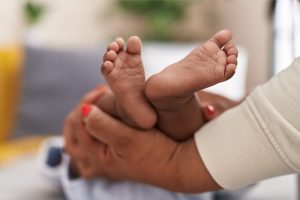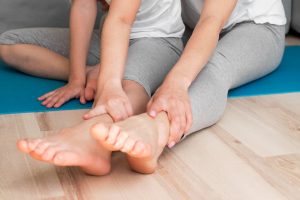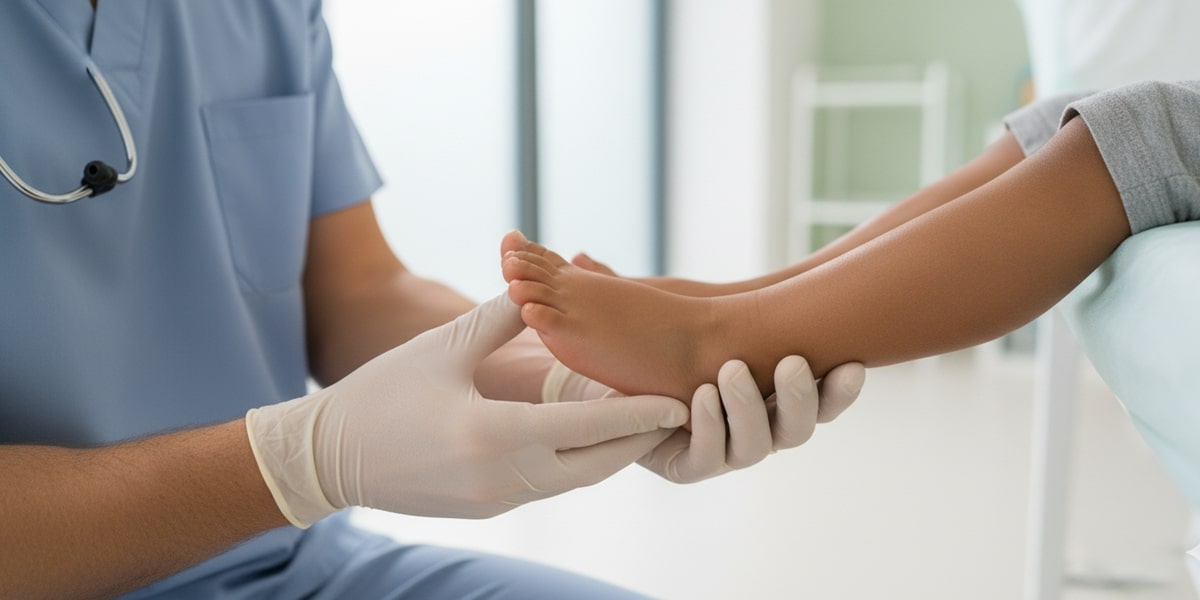Taking care of your child’s feet is important. At Foot + Ankle Specialty Centers in Gilbert, our doctors treat all kinds of foot and ankle problems in kids. We use safe and proven treatments that get real results. Want to understand how your child’s feet grow and how to keep them healthy? Call us or book an appointment online. If you’ve been looking for a kids’ foot doctor in Gilbert, this guide will help.
What Does a Pediatric Podiatrist Do?
A kid’s foot specialist diagnoses and treats foot and ankle conditions in children. They handle many issues, from ingrown toenails and flat feet to birth deformities and walking problems.
They offer treatments both without surgery and, when needed, surgical solutions that are designed for young patients.
Why Choose Our Pediatric Podiatrists in Gilbert?
Our patients trust us because we:
- Treat babies through teens.
- Use gentle care made for growing feet.
- Explain things in terms kids understand.
- Create care plans just for your child.
Causes of Pediatric Foot Pain and Problems
Here are things that can lead to foot pain in kids:
- Some kids inherit flat feet or very high arches.
- Shoes that are too tight or poorly shaped cause issues like bunions or ingrown toenails.
- Injuries from accidents or falls can cause fractures, sprains, or cuts.
- Sports or heavy activity can lead to overuse injuries like tendonitis or stress fractures.
- Being overweight adds extra pressure to feet.
- Poor alignment when standing or walking can lead to problems.
- Infections (fungal, viral, or bacterial) can cause conditions such as athlete’s foot or warts.
- Rapid growth can cause conditions like Sever’s disease, where growing bones and tissues are stressed.
What are the Most Common Childhood Deformities of the Foot?
Some foot deformities seen in children include:
- Low or no arch (flat feet), which may or may not cause problems.
- Clubfoot, where the foot is twisted at birth and needs early treatment.
- Metatarsus Adductus, where the front part of the foot turns inward; sometimes it goes away on its own.
- Intoeing (pigeon‑toed), where feet turn inward when walking; often improves over time.
- Tarsal Coalition, where two or more foot bones are joined early, causing stiffness and pain.
Pediatric Foot Care Treatments in Gilbert, AZ
At our center in Gilbert, we offer treatments made for children. We aim for relief with as little invasiveness as possible. Here’s what we do:
- Custom orthotics to help flat feet, intoeing, and correct walking patterns.
- Physical therapy to strengthen muscles, improve flexibility, and support normal movement.
- Help choosing properly fitting shoes to avoid bunions or ingrown toenails.
- Minimally invasive surgery for serious deformities or injuries when conservative care doesn’t help.
- Targeted therapies for conditions like plantar warts, athlete’s foot, and Sever’s disease to bring relief.
- Education about foot hygiene, preventing injuries, and why good footwear matters.
How Long Does It Take to Treat Pediatric Foot Problems?
- Ingrown toenails may heal after one visit or take a few weeks.
- Warts usually take a few weeks to several months to go away.
- Athlete’s foot often clears up in 1 to 2 weeks.
- Flat feet may take several months or even years to treat.
- Clubfoot treatment often begins after birth and can last for years.
- Metatarsus Adductus may improve on its own within a few months.
- Intoeing is often watched over time and may get better without treatment.
- Sever’s Disease lasts a few weeks to a few months.
- Tarsal Coalition may require surgery and months of recovery.
- Sprains and strains take from a few weeks to several months to heal.
Pediatric Podiatry Specialist in Gilbert, Arizona
If you want excellent foot and ankle care in Gilbert, Foot + Ankle Specialty Centers is here. We care for all your child’s podiatric needs. Don’t wait to give your child the foot care they deserve. Let us help them walk, run, and play with confidence.
FAQs About Pediatric Podiatry
What is my toddler’s shoe size?
It depends on age, but most toddlers wear sizes 4–7 (US).
When should I take my child to a foot doctor?
If they limp, complain of pain, walk oddly, or avoid activities.
How often should I check my child’s foot size?
Every 2–3 months, since kids grow quickly.
What are signs of foot problems in children?
Pain, limping, toe-walking, uneven shoe wear, or frequent tripping.
Is it normal for kids to walk on their toes?
Sometimes, but if it continues past age 2, get it checked.
When should I see a podiatrist in Gilbert?
If your child has foot pain, deformities, or walking issues.
How can I prevent foot problems in my child?
Buy proper shoes, check foot growth, and watch for pain or changes.
Are flat feet a serious issue in children?
Not always, but if there’s pain or trouble walking, see a specialist.
Related Blogs

Pediatric Flatfoot Deformity and Its Treatment
Pediatric flatfoot is a common problem in kids. It means the arches in their feet don’t form the way they should. Sometimes, flat feet don’t hurt

What Are Clubfoot Baby Foot Problems?
Hearing that your baby has clubfoot is overwhelming. You may have many questions and worries about what this means for your child’s future. The good news

Pediatric Sports Injury Treatment and Signs in Arizona
Athletic children are always at risk of foot and ankle injuries. Running, jumping, and fast and sudden movements can easily injure them. So, children and parents


